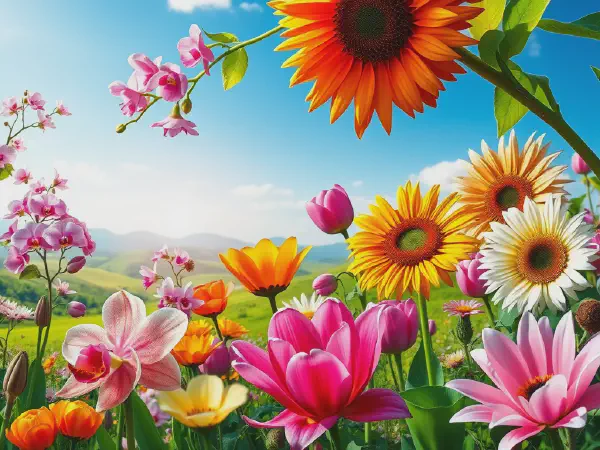Explore the Fascinating Types of Flowers in Nature

Exploring the Diverse Types of Flowers
Flowers come in countless varieties, each with its own unique characteristics and appeal. The types of flowers one might encounter can be broadly categorized into several groups, including edible flowers, wildflowers, garden flowers, indoor flowers, and rare or exotic flowers. This categorization not only helps to appreciate their beauty but also serves practical purposes in cooking, gardening, and conservation.
Understanding the different types of flowers enables gardeners and nature enthusiasts alike to choose the right blooms for their specific environments and needs. For example, edible flowers can enhance culinary dishes, while wildflowers contribute to biodiversity in natural ecosystems. Meanwhile, garden flowers are often chosen for their aesthetic appeal, whereas indoor flowers can significantly improve air quality and bring nature indoors.
Each type of flower has distinct features that make it suitable for specific purposes. For instance, while some flowers are celebrated for their fragrance, others may be prized for their visual impact or nutritional benefits. By exploring various types of flowers, individuals can better appreciate the richness they bring to both our environment and our lives.
From vibrant wildflowers that blanket meadows to delicately scented indoor blooms, the diversity of flowers is captivating. Moreover, rare and exotic flowers, often found in remote regions of the world, can carry great significance in terms of cultural heritage and ecological conservation. As we delve into the different types of flowers, we uncover the significance each has within its respective domain, revealing the multifaceted role they play in our world.
In this article, we will explore each of these categories in detail, examining the characteristics, benefits, and unique qualities of various types of flowers, ultimately highlighting their importance in both nature and human activities.
Edible Flowers
Edible flowers are those that can be safely consumed and are often utilized in culinary practices for flavor, decoration, or nutritional purposes. Common herbs and spices like chives, basil, and borage produce beautiful flowers that not only add visual appeal to dishes but also enhance taste.
Some flowers that are safe to consume include nasturtiums, violets, and calendulas, which add a pop of color and flavor to salads, desserts, and beverages. It's important to ensure that flowers are grown organically and free from pesticides before consumption.
Nutritional benefits of edible flowers can include antioxidants, vitamins, and minerals. For example, hibiscus is known for its high vitamin C content and potential health benefits, making it a popular choice for teas and syrups.
Wildflowers
Wildflowers are native plants that usually grow without the need for cultivated care. They are characterized by their ability to thrive in various conditions, often adapting to local climates and soil types. Wildflowers play a crucial role in natural ecosystems, providing food and habitat for diverse wildlife.
Common types of wildflowers include poppies, bluebells, and daisies, each bringing unique colors and textures to their environments. These flowers often bloom in specific seasons, attracting pollinators like bees and butterflies.
The role of wildflowers in ecosystems is vital as they contribute to soil health, prevent erosion, and support biodiversity. They help maintain balanced ecosystems by attracting pollinators and providing resources for other plants and animals.
Garden Flowers
Garden flowers are cultivated primarily for ornamental purposes. Popular garden flower varieties include roses, tulips, and sunflowers, each offering a range of colors and fragrances that enhance outdoor spaces.
Tips for cultivating garden flowers include selecting the right plants for your climate, ensuring proper soil drainage, and providing adequate sunlight and water. Regular maintenance, such as deadheading and fertilizing, can promote healthy growth and vibrant blooms.
Seasonal flowers can vary greatly depending on the region; for example, peonies thrive in spring, while chrysanthemums bloom in autumn. Choosing flowers according to the seasons can ensure a continuous display of color in gardens.
Indoor Flowers
Indoor flowers can brighten up living spaces, with popular options including orchids, peace lilies, and African violets. These plants come in various shapes, sizes, and colors, making them suitable for different interior design themes.
Care tips for indoor flowering plants often include monitoring light conditions, maintaining humidity, and ensuring proper watering practices. Keeping indoor plants healthy contributes to their blooming and overall longevity.
The impact of indoor flowers on air quality is notable, as many species can filter harmful pollutants and produce oxygen. Research has shown that houseplants can improve indoor air quality and enhance overall well-being.
Rare and Exotic Flowers
Rare and exotic flowers, such as the corpse flower or the black bat flower, are often sought after for their unique beauty and scarcity. These flowers can be intriguing due to their unusual shapes, colors, and sometimes captivating scents.
The conservation of exotic flowers is essential as many species face threats from habitat loss and climate change. Efforts to protect these unique plants often involve habitat preservation and cultivation programs to ensure their survival.
Cultural significance of unique flowers can vary widely, as different societies may attribute various meanings and uses to certain flowers. For instance, orchids often symbolize luxury and beauty, leading them to be valued in many cultures around the world.
